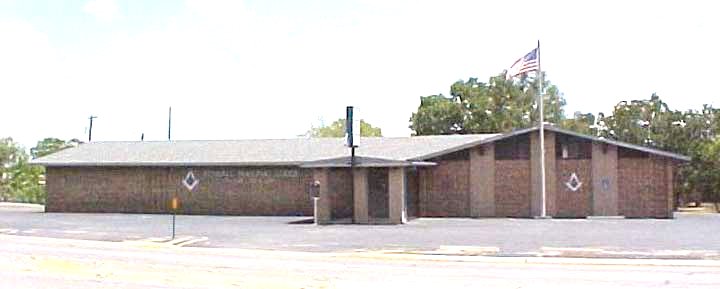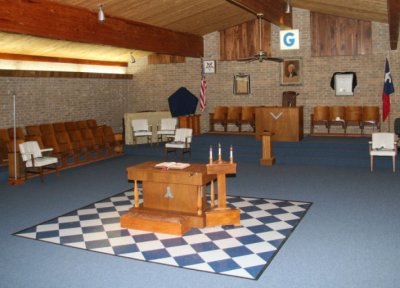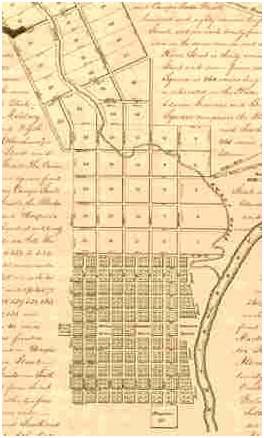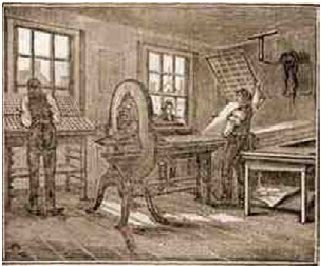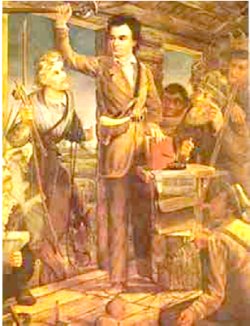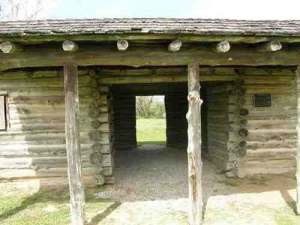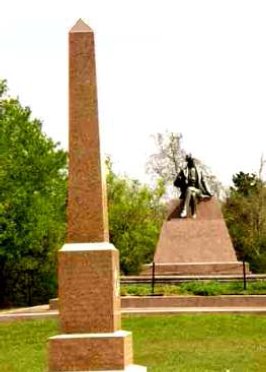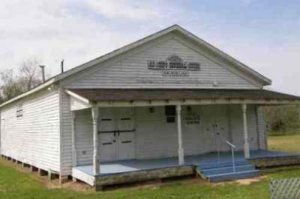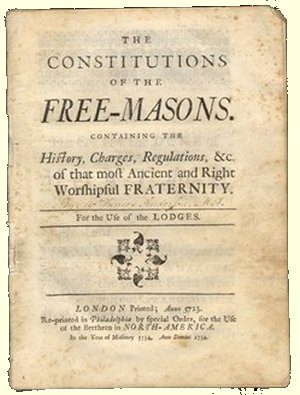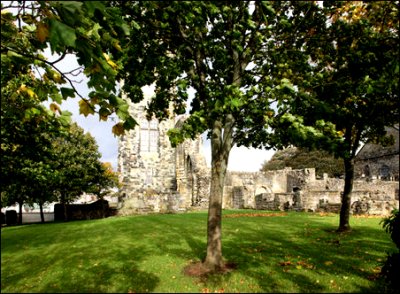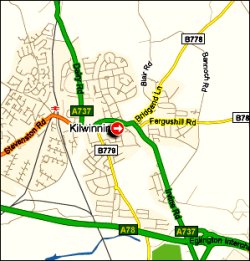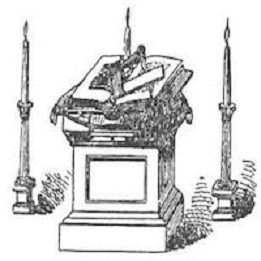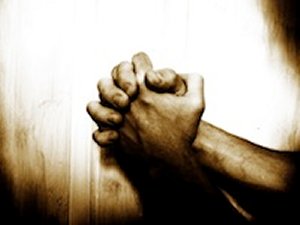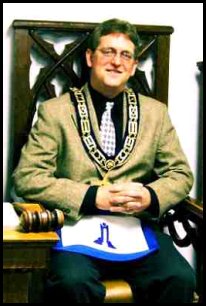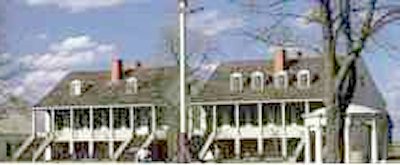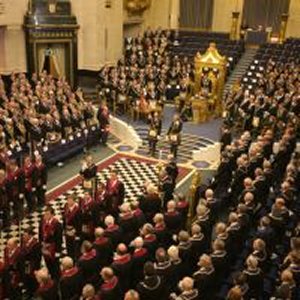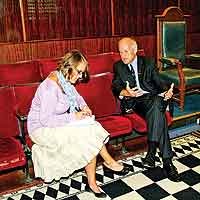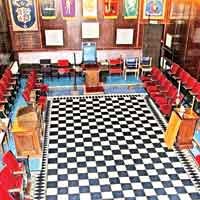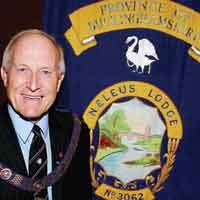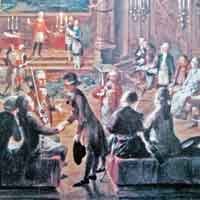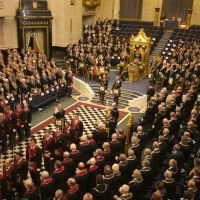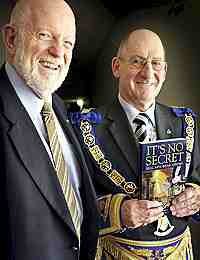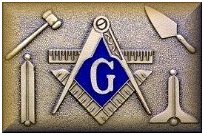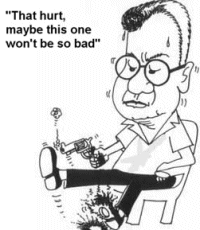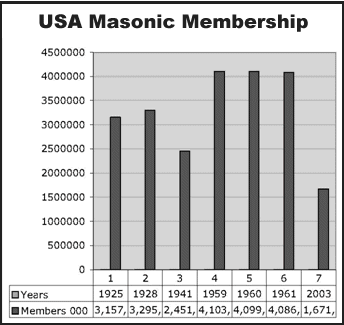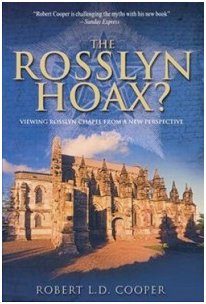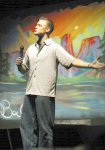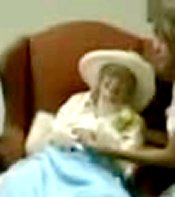
|
August 2010

Kendall Masonic Lodge #897 A. F. & A. M.
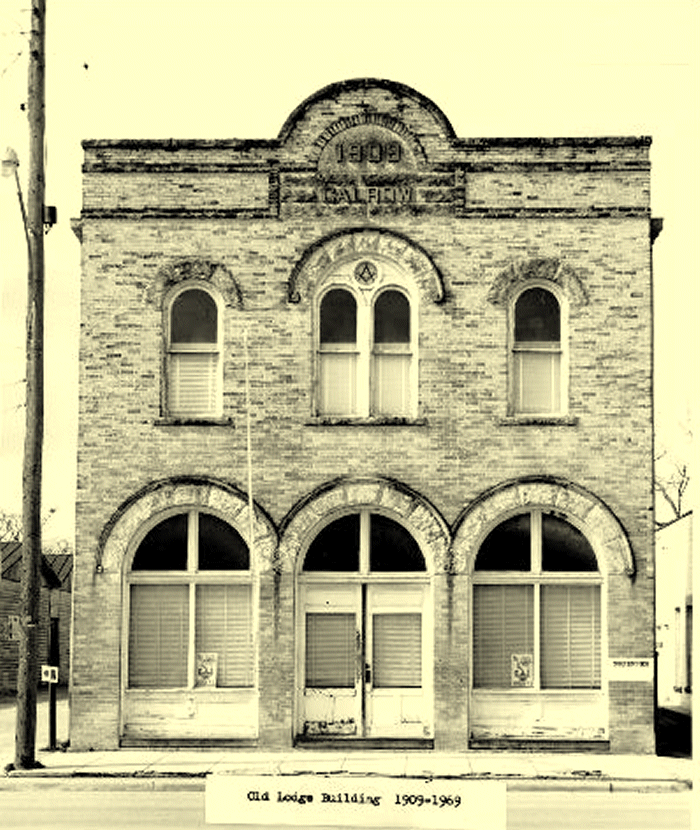 Kendall Masonic Lodge #897 A. F. & A. M. in Boerne, Kendall County |
|
Page II | |||||||||
This Small Town Texas Mason's E-Magazine is not affiliated with any state Grand Lodge or individual Blue Lodge. It was created to enlighten, educate and entertain Masons and non-Masons alike. As title suggests, each issue will feature a small town Texas Masonic Lodge and some Texas Masonic history or hero in each issue The beliefs, ideas and opinions expressed here are strictly those of the authors and not necessarily those of the editor, any individual Blue Lodge or any state Grand Lodge.
A very sincere effort was made to avoid using any copyrighted material, without permission or giving credit to the author, in the creation of this web site. If you discover something that is yours, without giving you due credit, please let me know and due credit will be given or the item will be replaced.
Any material in this site may be used to increase the understanding of Freemasonry.
Story tools: |
Kendall Masonic Lodge #897 A. F. & A. M.
This Issue's Visit In Texas Masonic History - SAN FELIPE DE AUSTIN, TEXAS
Our Brothers In Australia - The Third of Six?
First Masonic Book Published In America
Kilwinning Community Archaeology Project
Lack Of Proper Tiling Was Damaging To The Lodge
An Interview with Authour Bro Todd Creason
Two Salt Lake Tribune Articles on The Lost Symbol
What Freemasons Do Behind Closed Doors
Men-Only 'Society With Secrets' Dispels Myths . | ||||||||
|
Editor's Note; Some of our readers have ask about the “Waller Masonic Lodge #808 AF & AM Monthly E-Newsletter”. Click here http://mastermason.com/WallerNews/ to view. (Use your BACK ARROW to return here.) The e-version of the Waller Lodge newsletter was created to replace the printed version for members who have access to the internet to save printing and postage costs of those print newsletters. The savings is not huge, but for a small country town Lodge with only 72 members and 28 non members (Grand Lodge officers and some nearby Lodge Officers) receiving newsletters, the online version currently saves about 40% of the cost of providing the printed newsletter. The e-version is made as attractive to readers as possible in order to convert more members to the online version. It is divided into 2 sections. The first half is a duplicate of that month's printed newsletter enhanced with the addition of color and graphics. The second half includes both Masonic and non-masonic stories and features of interest.
If you think an E-newsletter would benefit your Lodge you may use any ideas or stories you wish from the Waller Lodge E-newsletters(Except Waller Lodge member specific information).
I do not keep a subscriber list for non-members, so you will have to bookmark the site address to return each month on the second Tuesday.
| |||||||||
|
Page V | ||||||||||
Continued From Page IV
Regular mail service in the colony was inaugurated in 1826 when Samuel May Williams
was appointed postmaster in San Felipe; with seven separate postal routes converging
here, the town remained the hub of the Texas postal service until the Texas
Revolution..
By 1830 John Cummins had constructed a grist and lumber mill near the town. As stock raising developed in the vicinity, small herds of cattle were driven from the town across the country to Nacogdoches. San Felipe was located only some eighty miles above the mouth of the Brazos, and keelboats were used extensively to transport goods between the town and various coastal ports. Nevertheless, most articles of commerce were carried overland to the coast by wagon until after the revolution. Unreliable water levels and turbulence during the spring rains discouraged steamboat traffic on the Brazos as far as San Felipe, and the stream's meanders rendered the water route to the coast far longer than land routes. However, after 1830 steamboats gradually began to appear on the lower Brazos, and by 1836 as many as three steamboats plied the waters between San Felipe and the coast..
Although the settlement was Catholic by law, no priests lived in San Felipe until the arrival of Father Michael Muldoon in 1831. Austin tried to discourage the Protestant churches from opening in San Felipe. So, Protestant worship in the town was confined mainly to occasional open-air meetings conducted by itinerant ministers. Thomas G. Pilgrim, who was a Baptist deacon from New York State, organized a Sunday-school at San Felipe, on the Brazos, in 1829. This was the first Sunday-school ever organized in Texas. the town's first churches were not built until after the revolution.. Many of the residents and visitors were Freemasons, but the earliest Masonic meetings in Texas convened in an oak grove near the town. Austin attempted to organize a Masonic lodge in 1828, when he and six other Masons met at San Felipe and petitioned the Grand York Lodge of Mexico for a charter dispensation. The petition evidently reached Mexico at the height of a quarrel between the "Yorkinos" and "Escoceses" (adherents of the Scottish Rite) and disappeared. The San Felipe Masonic Lodge #239 was not charted until June 14, 1860.. By 1836 San Felipe was the second largest town in Texas only San Antonio was larger. Its population in 1835 approached 600, and many more settlers resided nearby within the boundaries of the municipality. In view of the significance of the capital in the life of the colony, it was inevitable that San Felipe should play an important role in the events of the Texas Revolution. The conventions of 1832 and 1833 were held in the town, and as the site of the Consultation of November 3, 1835, San Felipe served as the capital of the provisional government until the Convention of 1836 met the following March at Washington-on-the-Brazos.. After the fall of the Alamo, Gen. Sam Houston's army retreated through San Felipe. On "The Settlement of Austin's Colony". March 30, 1836, the small garrison under Moseley Baker remaining at San Felipe to defend the Brazos crossing ordered the town evacuated and then burned it to the ground to keep it from falling into the hands of the advancing Mexican army. The terrified residents hastily gathered what few belongings they could carry before fleeing eastward during the incident known as the Runaway Scrape.
The town of San Felipe was incorporated in 1837 and became county seat of the newly established Austin County. A courthouse was constructed, but the town never recovered it's status as an important city. The only other buildings in the settlement by the mid-1840s were six or seven log houses and a tavern. Then in 1846 a county election made the new community of Bellville the county seat. January 1848 the county functions were gone from San Felipe.. Although the original inhabitants moved away from the town, they were replaced during the mid-nineteenth century by an influx of Germans. After the Civil War, freedmen began to take up residence in the community. Czechs moved into the area in the late nineteenth century, as did a large influx of Mexican immigrants during the early twentieth century; the Mexican influx resulted from an increase in the employment of Mexican migrant farmworkers in Austin County.. The people of San Felipe turned down an proposal by the Gulf, Colorado and Santa Fe Railway in the mid-1870s to route its new Galveston-Brenham spur through their town. However, the railroad was sold a right-of-way through the western section of the original 22,000-acre municipal tract.. In the early 1880s many residents and businesses moved from San Felipe to the new commercial center of Sealy after the Texas Western Narrow Gauge Railway constructed its Houston-Sealy spur through the vicinity. in 1882, the remaining residents of San Felipe moved to a new town site along the tracks. Proceeds from the sale of lands within the original five-league township were invested, and the resulting income enabled the town to function without taxation and to build a first-rate system of public education..
Typical Dogtrot Log Cabin Home. the town had 305 residents, one business, two churches, a school, and a post office. In 1990 the population was 618. The population was 868 in 2000. Well into the twentieth century the residents of San Felipe continued to claim the rights of the original inhabitants to free water, wood, grazing, and burial ground on the common lands of the municipality. In 1980 more than 700 acres of open land remained in possession of the community.. Most of the original town site on the banks of Bullinger's Creek now lies within the Stephen F. Austin State Historical Park, which was dedicated in 1928 and donated to the state by the town of San Felipe in 1940. The Farm Road 1458 bridge, constructed in the late 1940s, spans the Brazos near the site of the original ferry. The park is in two sections, historical and recreational. The historical section is near an old ferry crossing of the Brazos River. This area includes a replica of Austin's dog-run cabin where he conducted business of the first colonists. A monument sits on the site of the town hall, where the conventions of 1832 and 1833 and the Consultation of 1835 were held. There are many monuments and historical markers and a magnificent statue of Stephen F. Austin, "The Father of Texas"..
The park lies just north of San Felipe on Park Road 38. (Open Saturday & Sunday; admission fee.).
Compiled from Wikipedia, The Handbook of Texas, Britannica Online Encyclopedia,
The Lonestar.net, Austin County.com, The Colonial Capitals Of Texas.com and the
San Felipe de Austin Webpage, by John "Corky" Daut, P.M. Waller Masonic Lodge
#808 AF & AM.
|
|
Page VI |
Masonic FAQs
From The Freemasons Victoria
Is Freemasonry a Secret Society?
No. A Secret Society is generally defined as one whose existence is unknown to the public and is specifically denied. The existence of Freemasonry and its work in the community have a high profile publicly and individual membership of Freemasonry is no more secret than belonging to a football club or other service organization.
What are the Secrets of Freemasonry?
The secrets of Freemasonry are the passwords, signs and the handshake used by Freemasons as modes of recognition. Though there are elements of the ceremonial which are generally not discussed in detail they are by no means secret. Freemasons are sometimes reluctant to discuss these in order to retain an element of surprise for joining members in much the same way as the key points of a movie are not generally discussed in order to avoid spoiling the ending.
Freemasonry has long since ceased to have any real secrets. The passwords, signs and the full text of the ceremonies of Freemasonry have been printed in copious books, some more accurate than others, and widely published on the internet. One quick search on any respectable search engine should satisfy the curiosity of the skeptical or suspicious.
Why do you have secrets if you've got nothing to hide?
Freemasons persist in the practice of their traditional secrets in a purely symbolic fashion. The communication of these secrets is meant to act as a symbolic test of an applicants honour and trustworthiness. The symbolic keeping of a secret demonstrates to the candidate importance of being a man of integrity who can be trusted to keep his word.
Is Freemasonry a religion?
No. In general, a religion is defined as a set of strictly codified beliefs regarding the cause, nature and purpose of existence. A religion also generally offers a path to salvation or enlightenment. Freemasonry offers none of these things. Although Freemasonry requires its members to express a belief in an underlying principle of order in the universe it at the same time explicitly forbids discussion of the particular details of that belief.
Freemasonry is a sectarian organization that encourages tolerance and inter-faith understanding. The various religions represented amongst Freemasons include Christianity, Islam, Judaism, Buddhist, Taoist and many others.
Can women join Freemasonry?
Although the United Grand Lodge of Victoria does not accept female applicants to join traditional Craft Freemasonry there are many activities and groups within Freemasonry that welcome the participation of Women.
Traditional Freemasonry, as offered by the United Grand Lodge of Victoria, offers men in the community an important support structure that breaks down the isolation imposed by expectations placed on modern masculinity. Modern life offers very few emotional support structures for men.
Traditional Craft Freemasonry offers men an environment in which the development of masculinity can be appropriately nurtured, challenged and guided.
Why do you wear those funny aprons?
The traditional dress of Freemasonry, the apron, is a recollection of its symbolic beginnings in medieval stonemason's guilds. Traditionally, medieval masons wore aprons while working in the quarries, cutting and shaping the stonework for their buildings. The apron worn by modern Freemasons is an allusion to this customary story. The apron is predominantly white, symbolizing innocence, with decoration to show the wearers progression or office within the organization.
What happens at a Masonic Meeting?
A Masonic meeting is conducted along similar lines to any other club. General business is conducted including the presentation previous meetings minutes and the current finances discussed, visitors from other Lodges are welcomed, a lecture may be given or new members introduced to the Lodge in an initiation ceremony and the meeting is generally concluded with a meal and perhaps entertainment.
If you are curious about what goes on in a lodge the simplest thing to do is find out for yourself. Many Masonic meetings, particularly those of Grand Lodge, are open to the public. See our membership section for details of upcoming open nights. |
|
Page VII | |
Continued From Page VI
Is Freemasonry a Secret World Government? No. Freemasonry itself does not have a world governing body, each province and area being broken down into independent, wholly self regulating and autonomous territories governed by their own Grand Lodge. The lodges within Victoria, for example, report to the United Grand Lodge of Victoria. The United Grand Lodge of Victoria however reports to no higher body. These territories are (and in some cases are not) in amity with each other, maintaining correspondence and fraternal relations but in no way are they ultimately accountable to each other. Furthermore Freemasonry is largely a voluntary institution relying on the generous donation of its member's spare time. Given the locally independent and voluntary nature of Freemasonry it would be impossible for it to operate any kind of Secret World Government.
Is Freemasonry a Charity?
Freemasonry is not specifically a charity organization in that the general public can not make tax deductible donations nor can Freemasons Victoria solicit donations directly. Rather Freemasonry is an organization that encourages and facilitates the individual charity of its members locally, as well as on a large scale, coordinating charity efforts through the United Grand Lodge of Victoria's Board of Benevolence.
Freemasons are encouraged to be active in supporting their community and individual lodges are often involved locally supporting schools, sports teams and other community groups or restoring or maintaining community facilities such as playgrounds and parks. There are a number of methods to apply to Freemasons Victoria for charitable support including contacting the Board of Benevolence, the Freemasons Public Charitable Foundation or contacting your local lodge. | |
Among the many gems in the library's collection is the first Masonic book printed in America. The book is called The Constitutions of the Free-Masons and was printed in June 1734 by Benjamin Franklin.
Why did Franklin print this book? It seems likely that Franklin had perceived that copies of the first edition of the Constitutions (which was published in 1723 in London) were not easily available in the British colonies and, businessman that he was, he decided to print a new edition.
Franklin's Constitutions was printed when Franklin was only 28 years old, almost exactly at the time that Franklin became Grand Master of Pennsylvania. Interestingly, Franklin did not give himself credit anywhere within the book for being the printer. How do we know then that Franklin printed this item? One way we know is that scholars have attributed this book to Franklin's press on the evidence of the type used – a sort of typographical forensics. There is also further, secondary evidence, such as the series of advertisements for Franklin's Constitutions which first appeared in Franklin's newspaper, the Pennsylvania Gazette in May 1734, all explicitly stating that the book is "Reprinted by B. Franklin." It's interesting to note that Franklin called his edition a "reprint" (and didn't give himself credit as the printer anywhere in the book). In fact, if you compare his "reprint" to the 1723 edition, you can see that he tried to mimic the look of the original. (Speaking of mimicking the look of the original, a very well done digital (but not digitized) copy of Franklin's 1734 Constitutions is available here.)
Franklin's Constitutions is an exceedingly rare book. Three fairly recent bibliographic censuses have been done for this book – in 1971, 1974, and 2003 (see the end of this post) – each of which counted less than twenty existing copies of this book in the world. That being said, there may be more copies of the book in private hands. Our copy was described in the 1971 census by Harold V.B. Voorhis as follows. You will notice that many aspects of marks in this book are noted:
14 – Academy-Borneman Copy
I found this unbound copy in the Academy Bookshop in New York in 1933. It was purchased with a library in Long Island, New York, bound with other items and removed after purchased by the bookshop. It was sold to Brother Borneman of the Committee on Library of the Grand Lodge of Pennsylvania for $500. After his death it was sold at auction in the Parke-Bernet Galleries to an unknown bidder for $500. It is now rebound. On page 30 is the signature of "Lewis Evans" and on page 86 there is an unidentified word at the bottom. Several pages of the book contain circular water-marks about the size of a silver dollar. The circle is quartered by diagonal lines and in the quarters are the letters "S-P-D-S" starting at the top, reading left to right.
I will briefly address the watermark mentioned above, if only to say that while this is certainly evidence of a very interesting kind (although I've not been able to trace which paper maker used this watermark), it does not give evidence of who owned the book, but rather who had a hand, in a way, in making the book.
I'm interested in "marks in books" - those traces of evidence that tell us more about a book's past (for example, who owned a particular book before it came to reside in our library), and so I was excited to find out that, as mentioned above, our copy of Franklin's Constitutions contains the signature of a former owner of the book, Lewis Evans, as well as the date 1741. Lewis Evans was an important early mapmaker, draftsman, and geographer. He was an associate of Franklin's as well - and Franklin published the book that accompanied Evans's famous 1755 A General Map of the Middle British Colonies (another item in our collection, that we'll address in a future post).
A question that I'd like to answer, but haven't yet, is why did Lewis Evans purchase Franklin's reprint of the Constitutions? I haven't found evidence that Evans was a Freemason. Also, why did Evans obtain this book in 1741, as he presumably did, seven years after the book was published? Franklin most likely printed the Constitutions with the hope that members of various colonial Masonic lodges would buy up the edition. As late as 1750, though, Franklin was still advertising remaindered copies for sale.
Did Evans buy his copy out of curiosity about Freemasonry? Or, because he was a business associate of Franklin, did Evans obtain the book at a reduced cost or possibly even receive it for free, since Franklin was clearly not having an easy time selling out the edition he printed? These are questions I don't have answers for yet. I'm hoping that, with further research, more answers may possibly come to light. |
|
Page VIII | ||
|
The community archaeological project was conceived by Kilwinning & District Preservation Society and developed in the Kilwinning town regeneration plan to stimulate tourism and community activity within the burgh. The project includes excellent opportunities to link with education.
Having intially completed a feasibility study, Rathmell Archaeology has now been commissioned to support the project. Rathmell are keen to work with pupils from local schools and opportunities are currently being set up for schools to get involved.
The detailed plans are now being put in place for the work which will take place in August and September 2010, exploring the main historic remains in and around the town, including Kilwinning Abbey.
The project will cost £90,000, funded equally by the Heritage Lottery Fund and Irvine Bay, and with other support from North Ayrshire Council, Historic Scotland and West of Scotland Archaeology Service.
The core elements of the community-led project will be:
"But equally important, the discoveries made by the project will support the future conservation of the historic aspects of Kilwinning."
James Miller from the Preservation Society said: "This is a really exciting project. Volunteers, with professional support, will be involved in historical research, oral history studies, survey, excavation, post-excavation analyses and reporting tasks. The broader community will be able to provide input into the development of the project and to hear about the findings of the work through public meetings, leaflets and internet mounted resources."
| ||
By Gerald Edgar
For the record, here are the incidents where I found a lack of proper Tiling that was damaging to the Lodge.
As I have sat in close to 200 lodges in a dozen states & 3 countries since being Raised in July of 1973, I note Lodges "Tile" (or Tyle of your prefer) three ways.
1- Some do the traditional 'outside the closed door the entire meeting' (although some provide headsets, a peephole or the Tiler may have the door cracked open a bit)
2- Some have him sit directly in the doorway after opening Lodge.
3- Some (an increasing number unfortunately) have him sit completely inside the Lodge with the door either open or closed.
The 2 incidents I experienced were due to option 2 & 3.
First experience: The Tiler was sitting on the sidelines with the door open. Supposedly he would see or hear any 'cowan or eavesdropper'. But with the usual noises in the Lodge Room (people talking as we were reviewing some Degree work, fan or A/C running, etc) and the fact he was older AND not sitting right by the door, he did NOT hear some rustling sounds outside the Lodge room. I happened to be sitting near the door and have excellent hearing. I was sure I heard something and took a step outside the door but saw or heard nothing. A bit later I heard the sounds again, excused myself properly and went down the hallway. I heard the door to a restroom close so I made obvious footsteps as if I was returning back to the Lodge room but quietly came back near the restroom, standing behind a partition. After a minute or two a young man in his 20's stepped out, furtively look around and began tiptoeing to the Lodge room. I confronted him (shocked the heck out of him) and demanded to know who or what he was. He admitted he was not a Mason but claimed he thought he was in a church and had just stopped by to attend a 'service'. On closer examination he admitted he was an anti-Mason hoping to learn of 'secrets' or some nefarious act that he could condemn us with. Needless to say that Lodge NOW insists their Tiler stay OUTSIDE the Lodge room,
The 2nd incident was during the 2nd section of the MM degree, The Tiler was fully inside the Lodge Hall with the door shut tight.
Suddenly the door burst open and a woman walked in saying she was looking for a phone. She was driving thru town, needed to make a call (pre-cell phone days) and saw the large Lodge hall with cars all around so assumed we had a phone she could use.
This was a perfectly innocent event on her part but the Raising of the new Mason was seriously 'damaged' in the sense that it was interrupted and the 'atmosphere' and spirit of the moment lost.
I use these two examples to remind ALL Lodges to truly Tile their Lodges as a) we do have those who wish us harm and b) we do have those who will blunder inside for all sorts of reasons.
Feel free to share this message with your readership and I would ask them to share with all Masonic groups they belong to.
There ARE good reasons to Tile a Lodge Room!
|
|
Page IX | |
By Blake.
The question has been frequently answered by guess work or snap judgments. Recently, however, the Grand Lodge of Wisconsin undertook a serious study to find factual answers to the question. In 1969 a Research Committee headed by Past Grand Master Edward W. Stegner sent out a questionnaire to 729 "defaulted Entered Apprentices" to learn the reasons for their failure to advance.
The results of that canvass are the body of this Short Talk. To the concerned Mason, there is much food for thought in this report.
In Wisconsin, a candidate is "in default" after he fails to advance within one year. The survey of 729 defaulted Apprentices was started in late 1969, but it was February, 1970, before the returned questionnaires were tabulated and analyzed.
The questionnaire was sent to each individual with a letter over the Grand Master's signature, with a stamped, self-addressed envelope for the reply. Of the 729 men contacted, 204, 28%, returned the questionnaire - a surprisingly large response for such an inquiry. Even more significant is the fact the 190 responders signed the questionnaire, although that was optional. 155, or 77%, made personal comments or suggestions, which indicates that one out of five of the defaulted Apprentices still had considerable interest in the fraternal organization he had become a part of so briefly.
The tabulated results of the questionnaire furnish a summary of the information resulting from the survey; the following questions and statistics are taken from the Wisconsin Research Committee's 1970 report.
A. Do you feel you had sufficient direct personal contact with members of the Lodge prior to the acceptance of your petition?
The frequency with which certain problems were checked under Question G suggests a number of areas for Masonic study and examination. Granted that some candidates are making excuses for themselves in listing 'time" and "memorization" as the principal obstacles to their advancement, the fact remains that some of them (in their comments) challenged the archaic ritual of Freemasonry and the posting" requirements as obsolete and unnecessary. Could this be why 14 defaulted Apprentices "lost interest"? A thoughtful study of all the problems mentioned would stimulate recognition of the basic fact that candidates need more information, more Masonic enlightenment, and more stimulation than they seem to receive at present in the first stages of initiation.
The Wisconsin Research Committee reported that "we are more concerned in applying the yardstick to ourselves" than to the candidates, because "our next task is to remedy the situation." What prompted their purpose to find possible solutions was the many frank comments from the defaulted candidates themselves.
"These comments surprised us and caused the Committee, to do some real soul searching as to how we could improve our lodge operations, and whether we are meeting the needs of young men today. Is time (for Masonry) a limited factor in today's world, and if so, how can it be conserved for the candidate? Is the problem of memorization also a factor, due to time, and how can we assist in this regard?"
The comments are really the most interesting and provocative items in the survey. Unfortunately, space prevents their complete reproduction here. But since many of them are similar, they can be summarized by means of the following composite quotations.
"I'm too busy keeping my head above water in the rat race of modem life. I admire what Freemasons stand for, but I can't devote time to it, so I shouldn't become just a name on the roll of members."
"Masonic ritual and ceremonies might have appealed to me when I was 12. Now they seem childish."
"Attendance was very poor and the members were generally so much older I couldn't identify with the group."
"There is too much emphasis on memorization. Some of the work was even taught out of sequence and had to be relearned."
"Most of my evenings are taken up with school activities, book work, and helping the children."
"Lodge activities are not attractive to young men. Masonic work should be related to the present world."
| |
|
Page X | |
Continued From page IX "The lodge kept changing the date I was to appear again. Last time, they called me just before the meeting. I had another commitment. A new Mason should be better informed, and soon enough." "My wife didn't like my joining the Masons. I have to keep peace at home." "Thank you for your interest and concern about me. I'd like to continue, but at present just don't have the time." "I was much younger than most of the members, which caused feelings hard to pinpoint. But inside I feel it's the greatest fraternal organization a man can encounter. I hope some day to continue." "I hope very much to continue, but lack of time and a poor memory hinder me somewhat. My father is a Mason. I will keep trying." "I was never called after that. I did not feel it was up to me to tell the lodge what to do." "After the first degree I was moved to obtain more education. I would like to finish the Masonic work, but it will have to wait till I get my degree." "I lost interest in the lodge because of the gentleman who was my instructor." "When I was working to become a Mason, the Brothers showed no interest in helping me, so I gave up trying to join. When I considered joining somewhere else, I was told there was a lot of red tape to go through. I'd sincerely like to become a member in good standing if the organization itself showed some interest in helping me to get this all straightened out." "Your letter and questionnaire is really the first sign I have had that Masonry is interested in me. I'd like to continue, and I'd like to meet you." Some of these responses cry out for good Masonic rejoinders, but those must be left to the particular Lodge whose business it is to make a Master Mason of the individual candidate it has investigated and accepted. One may be tempted to ask of some of these commentators, "What did you expect?" But one should really ask the Lodge, "What did you teach him to expect?"
The Wisconsin study of defaulted Entered Apprentices suggests that the problem of good public relations begins "right at home" with the particular Lodge. What does the local community expect of a Lodge of Master Masons? In Masonic language, "Is the community convinced of the good effects of our fraternal association?"
| |
The question is a great example of a "circular argument." This logical fallacy begins with the conclusion: that Masonic meetings are worship services where men professing various faiths join together to worship a God other than "Yahweh, the God of the Bible." The argument simply travels around in circles until it comes back to its original statement, concluding that Masons worship a God other than Yahweh (or Jehovah).
Praying in Lodge Meetings
Prayers voiced in Lodge meetings do not make the meeting a worship service. If so, then sessions of the U.S. Congress would be "worship services" as a chaplain or invited clergy leads in prayer to open the session. Congress has been accused of many things, but never of holding worship services. If prayers make a meeting a worship service, the same criticism could be leveled against organizations such as the Lions Club, the Boy Scouts, and the VFW.
Until recent years, prayers were offered at high school ball games by clergy in the community. Courts have repeatedly ruled that prayers may not be offered before such events. Critics complain that "God has been taken out of public school" because prayers may not be given by administrators or visiting clergy at the beginning of a school day. Students, however, are allowed to pray on their own initiative, either alone or with other students who wish to join them in prayer. Masons alone have been singled out by critics for praying in meetings while these same critics complain that the official prayers are not allowed in public schools.
Praying in Jesus' Name
Some Masonic critics are not opposed to prayer in Lodge or other meetings, even when non-Christians are present, but are opposed to the prayer when it does not conclude with the specific words, "in the name of Christ." They cite John 14:13-14, where Jesus said to his disciples, "I will do whatever you ask in my name, so that the Father may be glorified in the Son. If in my name you ask for anything, I will do it" (NRSV).
Bailey Smith, a recent president of the Southern Baptist Convention, made headlines in 1980 when he said God does not hear the prayers of a Jew. Smith's position and that of Masonic critics is that God only hears prayers ending with "in Jesus' name" or prayers of repentance.
Preschool-age children are taught to pray simple prayers. They seldom end it with the phrase "in Jesus' name" and most have not made what evangelical Christians call a profession of repentance and faith in Christ. Do Masonic critics believe God hears the prayers of these children? Are we misleading children when we tell them God hears their prayers? I believe God hears the prayers of every sincere person, and I do not think we are misleading children when we tell them God hears and answers their prayers.
It was drilled into my head by my professors during seven years of theological education that a correct interpretation of a biblical text requires examination of the surrounding text, which often helps an individual understand the text in question.
|
|
Page XI | |
Continued From Page IX
Jesus responded to Philip's question, "Have I been with you all this time, Philip, and you still do not know me? Whoever has seen me has seen the Father. How can you say 'Show us the Father'?'
When Jesus said in verses 13-14, "1 will do whatever you ask in my name," he was claiming deity. He was saying, "God will hear your prayers if you pray in my name because "I am in the Father and the Father is in me."
Jesus did not mean that unless a person concludes his prayers with the words, "in the name of Jesus," God would not hear nor answer prayers.
William W. Stevens, my theology professor at Mississippi College, wrote in his Doctrines of the Christian Religion (1976), "'In my name' means according to his will and purpose, in direct union with him. It implies unity of thought and interest. One cannot pray in the name of Jesus and pray selfishly" (p. 269).
The Expositor's Bible Commentary (Vol. 9, p. 146) says, "Me phrase 'in my name,' however, is not a talisman [magic object] for the command of supernatural energy. He did not wish it to be used as a magical charm like an Aladdin's lamp."
Men look on the outward appearance and judge others by the words used in a prayer (Matthew 6:5-8). God looks at the heart. He knows what we need before we ask. If the prayer is a genuine desire to talk to the Father of all creation, He will hear and answer the prayer, whatever words are or are not used. That is the kind of God I know from my reading of the Bible and from hours spent on my knees talking to Him.
During my ministry as a chaplain supervisor in the Olympic Village during the 1996 Atlanta Olympic games, chaplain volunteers from six major world faiths joined together in prayer every day. Chaplains rotated leading the group in prayer. Out of respect for chaplains who did not share our faith, we did not always verbally close our prayers "in Jesus' name."
Rev. James Draper, president of the Southern Baptist Convention's LifeWay Christian Resources (formerly the Sunday School Board), resigned from Estelle Lodge No. 582 in Euless, Texas, in 1984 after election for his second term as president of the Southern Baptist Convention (SBC) and as the Masonic controversy was heating up in the SBC. He had transferred his membership from Dell City Lodge No. 536 in Oklahoma when he became pastor of the First Baptist Church of Euless. In his letter of resignation, Draper, who served one year as chaplain of his Lodge, said he always concluded his prayers "in Jesus' name."
Praying to The Great Architect of the Universe
Masonic critics have long and loudly argued that Masons do not pray to Yahweh when they pray in Masonic Lodges. Masonic critic William Schnoebelen refers to the "generic" god of Masonry, "God-to-the-lowest-denominator" and "Mr. Potato-Head God" when speaking of the Great Architect of the Universe (Masonry: Beyond the Light, pp. 44-46).
Another critic, John Ankerberg, quotes from Coil's Masonic Encyclopedia to argue that Masons believe Yahweh (or Jehovah) is inferior to "the universal god of Masonry" (The Secret Teachings of the Masonic Lodge, pp. 113-14). Ankerberg's quote is not in the 1995 edition of Coil's Masonic Encyclopedia, the most recent edition, except for a single sentence, "The Masonic test is [belief in] a Supreme Being, and any qualification added is an innovation and distortion." This sentence is simply a requirement that men who desire to become Masons must believe in one God (monotheism). Monotheism is affirmed in biblical statements such as Deuteronomy 6:4, "Hear, 0 Israel! The LORD is our God, the LORD is one!" No statement in Coil's Masonic Encyclopedia suggests that Masons believe Yahweh is an inferior God.
The phrase Great Architect of the Universe came into Freemasonry as early as 1723, according to Coil's Masonic Encyclopedia, when it appeared in James Anderson's Book of Constitutions. Anderson, a Scottish Presbyterian minister in London, did not invent the phrase. It was repeatedly used by Reformed theologian John Calvin (1509-1564). "In his Commentary on Psalm 19, Calvin states the heavens 'were wonderfully founded by the Great Architect.' Again, according to the same paragraph, Calvin writes 'when once we recognize God as the Architect of the Universe, we are bound to marvel at his Wisdom, Strength, and Goodness.' In fact, Calvin repeatedly calls God 'the Architect of the Universe' and refers to his works in nature as 'Architecture of the Universe' 10 times in the Institutes of the Christian Religion alone" (Coil's Masonic Encyclopedia, p. 516). If we accept the logic of Masonic critics, then Calvin must have believed the God revealed in the Psalms and elsewhere in the Bible is a false god. This, of course, is absurd, as are all of the Masonic critics' arguments.
Federal Reserve Notes ($1 bills) proclaim "In God We Trust." The U.S. Mint has not defined "God." It is used as a generic name for the Supreme Being. Individuals may define God as they wish. In our religiously diverse nation, individuals of different faiths will define who they believe God is. I do not hear people calling for the removal of "In God We Trust" from Federal Reserve Notes because not everyone defines God as they do.
Praying with Persons of Other Faiths
On February 9, 1999, Baptist Press posted a story about several Midwestern Baptist Theological Seminary administrators and faculty members visiting mosques while on a trip to North Africa and the Middle East. Baptist Press states the administrators and faculty "were awed by the mosques which provided an atmosphere for prayer. Though the local worshipers gathered to pray to Allah [the Arabic word for God], Midwestern's group removed their shoes [as is the custom in mosques] and spent time praying to the God of their Christian faith."
Mark Coppenger, president of Midwestern Seminary in Kansas City, Missouri, was one of the Baptist visitors to the mosques. Coppenger said, "As we sat, and knelt, and stood [Muslims perform specific rituals which includes standing, kneeling and bowing while praying to Allah] in these moments of praise, confession, petition and intercession, it occurred to us that Christians would do well to have a similar location, atmosphere and posture for prayer." "It is a pity that non-Christians and sacramentalists [Roman Catholics] have appropriated the notion of houses of prayer, when ours is the heritage of orthodox prayer," Coppenger continued, referring to mosques and Roman Catholic cathedrals and retreat centers. "We have let them lead in an emphasis on prayer by default."
When the group returned to Kansas City, Coppenger decided to provide a place for prayer similar to that in mosques for seminary students. He removed hundreds of portable chairs from the chapel and laid down rolls of carpet. Students were asked to remove their shoes when they entered the "house of prayer," and a kneeling position was recommended.
Coppenger, his administrators, and faculty joined Muslims at prayer in a mosque. They reported they were able to pray to Yahweh even while Muslims were praying to God whom they call Allah. Coppenger and his team even followed the Muslim practice of bowing, kneeling, and prostrating themselves during the prayer ritual and still found they could pray to Yahweh. I have never felt I could not pray as my chosen faith leads me while standing next to someone in a Lodge meeting who does not share my faith.
Freemasons Do Not Worship in Lodge Meetings
In conclusion, Masons do not worship in Lodge meetings. Each Mason freely prays as his faith dictates, regardless of who is leading the group prayer, because prayer is ultimately a personal encounter and conversation between a man and his Creator.
Source: Rev. and Bro. Leazer |
|
Page XII | |
By Brother Ken
Thanks for doing this e-interview for MasonicTravels.com and introducing yourself to our readership. Now, I am familiar with your Masonic affiliations, but would you care to share them with us here?
I haven't been a Mason very long. I joined Ogden Lodge No. 754, in Ogden, Illinois in 2005, and I'm currently the Senior Warden. I became a 32º Mason in Spring 2006 at the Scottish Rite Valley of Danville, Illinois (NJ), and most recently, in Spring of 2008, I joined the York Rite. I'm a member of the Champaign Chapter No. 50 Royal Arch Masons, and a member of the Knights Templar Urbana Commandery No. 16—both in Illinois. I enjoy membership in several Masonic research organizations as well—the Illinois Lodge of Research, the Philalethes Society, and the Scottish Rite Research Society.
People join Freemasonry for a variety of reasons, what made you knock upon the door?
I'd have to admit it was curiosity. I've been running across the occasional reference to Freemasonry in my studies of American history for years. But I'd have to admit, I became fascinated with it due to books like Dan Brown's “The Da Vinci Code” and movies like “National Treasure.” So I began researching Freemasonry. Shortly after, I ran into a friend of mine who I knew was a Past Master of Ogden. I had no idea when I filled out that petition that I was making such an important decision, but without question, it was one of the best decisions I've made.
How did you first become interested in researching famous Freemasons and what made you decide to write two books on the subject?
Shortly after I joined the Scottish Rite Valley of Danville, I was invited to take part in a historic degree based on actual events that took place during the American Civil War. It was an event I knew very well, and had read many accounts of over the years. But, what I didn't know was that just about every major player on both sides of that conflict was a Freemason. It made me wonder how Freemasons had impacted history—not the Fraternity, but the individual men. What I found was fascinating, and I realized almost immediately it would make a terrific book. I was right, the first book found an audience, and so I wrote a follow-up.
With the recent popularity of Dan Brown's latest book the Lost Symbol, many of our non-Mason readers might be interested in knowing if you have ever drank blood from a skull in your travels? If you did, would you tell me?
You know, I keep waiting to get summoned into that secret meeting where I'll be told the location of the Templar treasure, learn that Elvis is still alive, and be given the key to Area 51. But it hasn't happened yet. In reality, however, the secrets really aren't that secret—I read recently the secrets were published about two seconds after the Grand Lodge of England was formed in 1717. But people always want to believe there is more. Dan Brown tapped into that idea so many believe—that there is way more hidden behind the veil of “secret societies.” Brown has made a great living exposing the “secrets” of mysterious groups like Opus Dei, the Illuminati, and most recently, Freemasonry. But remember, Dan Brown writes fiction.
Did you enjoy the Lost Symbol?
I really did. I've read all his books, and I've really been looking forward to this one—he's a great storyteller. Dan Brown wove just enough about Freemasonry that is absolutely true to make the fictional aspects of his story believable. I think most people know the difference between fiction and non-fiction, but there are always those that get the two confused. I'm sure there will be those that believe everything they read in the book.
What do you think the impact on the Fraternity will be as a result of it?
I think Freemasonry is going to get a lot of attention, and I hope this attention makes people want to learn more about Famous American Freemasons! There are a couple good books I could recommend! But seriously, I hope the attention on Freemasonry makes people want to learn more about the fraternity. I'd like to think there will be those out there that want to learn more and knock on the door as a result.
Freemasonry, as you know from your research, has had some amazing members in its 300 years or so, what do you feel drew these fine men in to the Craft?
That's a good question, and one I've spent a lot of time thinking about. There isn't one answer. Men join for a variety of reasons, and each seems to get something unique out of it. In my opinion, I think one thing the fraternity shares with these remarkable men is industriousness—it's been a recurring theme in researching the lives of the famous Freemasons in my books. These famous men were in constant motion, and I know a lot of regular non-famous Masons that are like that too. It's almost an unwritten rule that Freemasons need to have at least three projects going at any given time. Freemasons are doers, and more often than not, the men that seek out the Fraternity are doers as well. I think that industriousness, at least in part, is why there are so many famous and successful Freemasons.
Freemasonry in the past 30 years has seen steady declines and aging membership, what do you feel are the most important points that we must address to remain strong in the coming years?
I can tell you what seems to work in the lodge I belong to, and several others in my area that are seeing growth—many for the first time in years. New members are encouraged from day one to participate. Those dedicated members that have kept the lodges open out of sheer determination as the membership dwindled over the years have gladly switched roles from being the leadership to being the teachers for “the next generation” of Masons. As a result, the new members have really gotten involved, they enjoy it, and they are dedicated to learning their ritual by the book (and there is no shortage of great instructors.) And word spreads to friends and family of these new members, and one new member becomes two, becomes four, and so on. In my lodge, with the exception of the Secretary, Treasurer, and Tyler, every officer in our lodge, including our Master, has been a Mason less than five years.
You have accomplished a lot in your Masonic career, and the question begs to be asked, what is next for you?
I'm going to take a break before I start a new book, and spend more time in lodge and less time in the library. It's funny how it's worked out. But the more successful the books become, the less time I have to do the things that originally inspired them. I'm going to get back to the basics for awhile, and I'm sure the next inspiration will strike—maybe another book in the Famous American Freemasons series, or perhaps it will be something completely different.
Todd, Thanks for joining me for this interview, and I appreciate you taking the time out of your schedule. I'm looking forward to seeing what's next, can you give us a hint as to what that might be?
I've got a collection entitled “A Freemason Said That? Great Quotes of Famous Freemasons” coming out in November 2009—just in time for Christmas. It includes quotes from Freemasons all over the world. It was a fun book to put together. And of course, I believe I promised Masonic Travels an article in the next few months.
Thanks for the interview, Ken!
Thank you Todd!
Todd Creason's Books: |
|
Page XIII |
|
Highlight Freemasonry and Raise Questions Posted by Brother Mark Koltko-Rivera
Two articles by Ms. Peggy Fletcher Stack in the Friday, October 16, 2009 issue of The Salt Lake Tribune discuss Dan Brown's novel The Lost Symbol, and along the way highlight Freemasonry and controversial aspects of Masonic history. Some Piercing Questions for Freemasons In one article, “Psst! Let's Talk About Masons,” Ms. Stack writes about Freemasonry as it is depicted in The Lost Symbol, and describes aspects of her visit to the Salt Lake Masonic Temple. She quotes R.W. John Liley (Senior Grand Warden of the Grand Lodge of Utah), Mr. Dan Burstein (editor of the forthcoming Secrets of The Lost Symbol), and myself. The article features an interesting photograph of a staircase in the Salt Lake Masonic Temple, a staircase of 3, 5, and 7 steps, each step labeled, for example, “LOGIC.” (No information was provided concerning whether this staircase is ever used for ritual purposes.) In one section of her article, Ms. Stack asks a couple of questions that she does not then go on to answer—but that we should. After quoting Dan Brown's letter of October 6 to the Scottish Rite, she writes: Sure, Freemasonry was once among the most common bands of brothers, where men met for "instruction" and networking. If it really is the humanistic haven Brown describes, why has the membership declined so dramatically in the past few decades? (It's down to fewer than 1. 5 million in the United States, from a high of 4.1 million in 1959, and fewer than 2,000 in Utah, from a high of about 6,000 in the mid-1960s.) Are its theatrical presentations, complete with bloodthirsty threats, really the way to enlightenment? As one of the people interviewed for this piece, I wish that Ms. Stack had asked me these particular questions, which I would have been glad to address. I would have pointed out the following:
However, the most important thing about this passage has to do with a couple of interesting word choices. She states that Dan Brown characterizes Freemasonry as a “humanistic haven,” and then implies that Freemasonry portrays itself as “the way to enlightenment.” Are these good characterizations of Freemasonry? I consider these appropriate aspirations. Heaven knows that not every lodge embodies Masonic values, and no lodge does so perfectly or all the time, but at its heart Masonry is supposed to be a “humanistic haven,” in the sense of showing forth important Enlightenment-era values: egalitarianism (being 'on the level'), devotion to the search for truth and self-improvement, and toleration of different religions and political viewpoints. At the same time, Masonry does have ties to important pre-Enlightenment values: the fulfillment of one's duty to the Divine; being (literally) centered on the teachings of the Volume of the Sacred Law; the entire notion of keeping sacred obligations. Ms. Stack seems to imply that if this were really true of the Lodge, then we would not have suffered membership decline. Perhaps this is so. Ultimately, though, the main concern I have is that the typical Masonic lodge really should embody the values that Dan Brown says we do. We need to live up to the standards of our best selves and highest aspirations. As far as enlightenment is concerned: Different traditions define what is meant by 'enlightenment' in different ways. To make a very broad distinction, one may consider a spiritual enlightenment, on the one hand, and an intellectual enlightenment on the other. It may well be that Freemasonry can contribute to each one (perhaps the topic for future blog posts). However, if it is to make that contribution, then certainly some of the work of the Lodge at our Stated Communications must be to foster that enlightenment, through education in the meaning of our esoteric symbolism (not just in the performance of our esoteric ritual). If we provide that kind of access to enlightenment, on a consistent basis, then issues of retention, certainly, will evaporate. The Mason-Mormon Connection In another article, “Mormons Off the Hook in Brown's Book,” Ms. Stack notes that a major theme of The Lost Symbol, apotheosis, or the potential for human beings to become gods, is an echo of the Latter-day Saint ('Mormon') doctrine of exaltation. (I consider this matter in some detail in a post on another blog.) I am quoted in this article, as well. Ms. Stack touches briefly on the complicated history of relations between the Latter-day Saints and the Grand Lodge of Illinois in the early 1840s. She mentions one of the great hairy issues still unresolved from the period, the matter of the relationship between the Masonic rituals of initiation and the Latter-day Saint temple endowment ceremony. Perhaps it's just me—I'm sensitized to both sides of the issue, being a Latter-day Saint Freemason, or a Masonic Mormon, take your pick—but I think I've seen the profile of this issue slowly rising over the last decade or so. The LDS have seen a 50% increase in membership during this period, and the Masonic Lodge has seen an increase in the number of new petitions, as well; perhaps that is why a variety of people—anti-Masons, anti-Mormons, Masons and LDS, and the curious John Q. Public—have shown more interest in the whole Mason-Mormon thing. I have been writing a book on this issue for some time. Perhaps I need to blog about it as well. It's a complicated issue, but one concerning which it would be wise for Freemasons to educate themselves, given the certainly rising profile of Freemasonry and the Latter-day Saints, and the possibly rising profile of their long-ago association. For the record I'll just throw out a few points:
I must say, I have been stunned to read the virulently anti-Mormon tone of some early-to-mid-20th century Masonic writers. I would hope that, as these two growing organizations more frequently bump into one another in this shrinking world, we'll see less of that.
|
|
Page XIV | ||
Freedom Lodge No. 100 - Fredericksburg, Texas 1851 – 1856
The first officers of Freedom Lodge UD (under dispensation), some of whom bore familiar names, were Thomas C. Doss, Worshipful Master; R.W. Reynolds, Senior Warden; Joseph K. Wilson, Junior Warden; H.E. McCulloch, Secretary, W.C. McKean, office unavailable; J.S. Shultz, Deacon; H. Dillard, office unavailable; and William Gordon, Tyler. The dispensation was authorized and signed by Andrew Neill, Deputy Grand Master. The organizational meeting of Freedom Lodge UD was held on I November 1851.
After over a year's wait, a warrant was awarded Freedom Lodge No. 100 by the Grand Lodge of Texas on 23 January 1853 by action taken at the Grand Communication, which was held in Nacogdoches during December 1852. The elected Charter officers of Freedom Lodge were Joseph K. Wilson, Master; Thomas C. Doss, Senior Warden; and Chester B. Starks, Junior Warden.
An indication of the difficulty the new Lodge was suffering in building its membership is exemplified by the 1855 request of Freedom Lodge. The Grand Lodge of Texas to allow the lodge to work in the German language at least once each month. It could be deduced that this request was made to satisfy the needs of the local German-speakers whom the Lodge was interested in attracting to its membership, especially in view of the declining Lodge membership at-that time. The request was granted, but a request that the Lodge be allow to keep minutes and to submit returns in German was denied. It may be that the request for German language records alludes to the possibility that there was a German-speaking Mason in line for the position of lodge Secretary or the hope that if German was the official language of .the Lodge, that it might survive regardless of the declining membership of English-speakers.
According to Persistent rumors, Freedom Lodge No.l00 formed and met at Fort Martin Scott, which is located on the eastern edge of Fredericksburg. To date, there are only two written references to Fort Martin Scott in relationship to Freedom Lodge. The first reference is found in a handwritten paper by Brother Fred Mathisen, Past Master of Fredericksburg Lodge, first entitled ”Historical Data, Fredericksburg Masonic Lodge #794 A.F.&.A.M.'" The original title of the paper was crossed out and replaced with a new title. "Masonic Lodge Starts Building." The paper appears to have been created sometime during 1962 as a press release announcing the beginning of construction of the then then new Fredericksburg Lodge building. Following is an excerpt from his paper.
The second reference to Fort Martin Scott in association to Freedom Lodge is found in a report of the District Deputy Grand Master to the Grand Master of the then Fourth Masonic District. An excerpt of the report follows:
During the period that Freedom Lodge existed, there were two Masonic Brothers that we know were soldiers assigned to Fort Martin Scott, namely William Gordon' and William H. Little. Brother Gordon is listed in the 1851, 1852 and 1853 Grand Lodge returns as “Tyler" Brother Little is listed in the 1852 and 1853 returns as an Entered Apprentice. One can only guess how many other members of Freedom Lodge were soldiers or civilian employees at the fort. With few German surnames appearing on the roles of Freedom Lodge, the makeup of the Lodge must have come from a center of influence made up of English-speakers and the fort was just such a place.
Grand Lodge records do not record the attendance of any Freedom Lodge. members at any of the Grand Lodge communications during the life of Freedom Lodge. The only mention in Grand Lodge proceedings regarding attendance and Freedom Lodge was when the Grand Lodge of Texas was called to labor on l8 January l853; the committee on credentials reported the name of A. Neill as Representative from Freedom Lodge No' 100. This same A. Neill, or Andrew Neill, was elected Grand Master at that 1853 Grand Lodge communication. Fourteen years later on 5 February 1867,Holland Lodge No. 1 preferred charges of un-Masonic conduct, with all proper specifications, against Brother Neil. The said charges and specifications were based upon and included all the acts and doings of Brother Neill during the time that he held the office of Grand Treasurer of the Grand Lodge of Texas. Past Grand Master and 1853 Grand Lodge Representative for Freedom Lodge No. 100. Andrew Neill was subsequently expelled by the Grand Lodge of Texas in 1867 for un-Masonic conduct.
Sadly, the demise of Fort Scott, coupled with the lack of German settler membership, forced Freedom Lodge to go dark. In June of 1855, finding their numbers too few to continue work, Freedom Lodge No. 100 surrendered its charter, funds and jewels to the District Deputy Grand Master, S. G. Newton, who delivered them to the Grand Treasurer.
From the book, “Freemasonry In Gillespie County”, part of a research paper presented to Texas Lodge of Research Grand Lodge of Texas March 2007 by James Murdock McCrae Past Master, Fredericksburg No. 794 A.F.& A.M.
|
|
Page XV | ||||||
|
Written by Polly Manser
"DON'T ASK too many questions, you might get murdered," was the advice from a friend when I said I had arranged to interview a deputy provincial grand master in an attempt to find out what freemasons actually do behind closed doors.
I had been keen to set up this meeting ever since I discovered that Beaconsfield is a hotbed of freemasonry, with secret ceremonies taking place in the town as often as once a week.
It is hard not to be intrigued by a society which dates back to 1646 and whose members still perform rituals in which they agree to have their throats cut, their tongues torn out by the root, and to be buried in sand at the low water mark if they fail to abide by the rules.
Google freemasonry and you'll also find a book for or sale in the US claiming to reveal the "darker side" and to "expose the closely guarded secrets of the world's oldest secret society that men have been murdered for revealing."
So I wasn't sure how things were going to go when I arrived at the sprawling, dark Victorian former school house in Windsor End which is the meeting place for 450 of the 3,800 or so freemasons in Buckinghamshire. Parking outside, the place appeared empty.
However, he had a nice face, a friendly smile. He didn't look in the least bit sinister; in fact I immediately warmed to him. We chatted in the corridor for a bit, before entering the temple.
The room was about 40 feet long by 20 feet wide, surrounded on all sides by two rows of red velvet chairs. At the centre point of each row were one or two large throne like seats. On the floor, a striking black and white squared carpet, resembled a chess board. The walls of this imposing wood-panelled, vault-ceilinged room were adorned with banners and gold lettering.
It was strange, to say the least, to imagine up to 100 men gathering in this room wearing morning suits, masonic aprons and, in some cases, gauntlets to either act out or watch rituals in which trouser legs are rolled up, shirts are opened, and words written in the early 1700s recited. Those who transgress against a brother mason agree to having their hearts "torn from their breasts and fed to ravenous birds" or being severed in two and having their bodies turned to ashes and those ashes "scattered over the face of the earth and wafted by the four winds of heaven." In initiation ceremonies new recruits are blindfolded with silk scarves, and rituals can include holding sharp instruments across bare chests.
This, I had read on the internet. To my surprise, Clifford confirmed that it happens, for up to 90 minutes each week, adding that the words are purely symbolic.
He said: "These rituals are saying if you betray my secret you will be killed. Through these ancient words we retain our link to the past. But of course if somebody breaks my trust I'm not going to cut out their tongue or bury them at low water mark. I live 50 miles from the coast in any case. " He laughed.
"It's all about fellowship, a shared experience. The rituals are mini plays. Everybody has to learn their lines, you rehearse and there's a performance." A bit like playing in an orchestra, I suggest. "Exactly like that," he said. Through ceremonies good men are taught to become better men, using lessons of social and moral virtues.
I asked about the temple. "The black and white floor represents light and shadow; the joys and sorrow of man's chequered existence," he said. We went over to the largest of the throne-like seats. "This is the master 's chair. The cushion on the desk is for the Volume of the Sacred Law which symbolises the values we hold to. The hammer is used to commence the meeting."
He answered my questions about two stones, a rough piece of ashlar, and a smooth, cube-shaped piece of marble. The former symbolises a new recruit to the freemasons; rough around the edges. The latter symbolises a freemason who has progressed through the ranks and learned the craft; how to follow the masonic rules of friendship, decency and charity.
Stonemasons' tools, which were displayed on a table in front of the deputy warden's chair, symbolise the character traits required to join the fraternity, he said. "The square is for square conduct, the level for level steps, and the plumbrule for upright intentions." He adds that freemasons don't let just anybody in.
He became a freemason at the age of 27, when he was invited to join by a friend who was already a member, and who admired his community work organising football coaching for 120 teenagers each week.
Through the freemasons, he said, he has made hundreds of friends. His wife Linda is , as a woman, not allowed to attend the men-only he attends, but the couple's social life is built around people they have both met through the society. Last weekend they went camping with ten other freemasons.
Critics of the freemasons, among them Martin Short, author of The Brotherhood, claim that they join the organisation in order to feather their own nests; to make contacts that will help them materially in business, the police and the law.
It's an allegation that Clifford denied. "It's something that's often levelled against us. But the truth is the complete opposite.
"Of course, if I need a plumber, and I know a plumber in the freemasons, I'll talk to him about the job. I'll know he's of good character and he'll probably give me a good price. But the same would be true of anybody. If you need somebody, you look to who you know, it's human nature."
"Freemasonry is a force for good in society. We don't go around rattling tins, we give our own money," Clifford said, adding that his "lodge" - the group of 26 masons of which he is a member - has raised £44,000 over 20 years. In Buckinghamshire, freemasons donated more than £100,000 per year to community projects and individuals in need, including this year £7,250 towards a new kitchen for a scout group in Iver Heath. They are co-sponsoring a new blog for teenagers in Chesham called Get Out Get There, and this coming weekend (June 19/20) will be presenting cash prizes of up to £1000 to the regional winners of i-help, a project which encourages young people to help others in the community. In Buckinghamshire
Clifford would never use the freemason's secret handshake or any of the secret passwords outside of the temple. And no he wouldn't demonstrate the handshake on me, saying, very politely: "Some things are sacrosanct."
Pictures: Clifford Drake talks to Polly Manser in the temple at Beaconsfield, Clifford Drake with the banner of his 'lodge', a secret ceremony taking place in the 18th century, and a ceremony of the United Grand Lodge in London.
|
|
Page XVI | ||
|
But Not Mystery
By Thomas Hunter
Grand Master Garry Sebo is wearing a gold-braided apron; large Star Trekish cuffs over the sleeves of his suit coat; and a chunky mayoral chain with blue ribbons tied at the shoulder.
He's standing at a lectern somewhere deep inside Dallas Brooks Hall telling journalists how a new, not-quite-tell-all book on Freemasonry has been written to dispel the view that the brotherhood is "sinister and people need to be careful of us".
"[That perception] is our own fault," he admits.
"We've carried as if we've had something to hide ... We are not a secret society, but we are a society with secrets."
The moment of crisis came last year when the fraternity learned Dan Brown's new book - The Lost Symbol - would be about Freemasonry.
Fearing it would do for their club what The Da Vinci Code did for Catholicism, the Grand Master and others conceived the new book as a corrective.
To their great relief Brown's blockbuster was gentle on the 293-year-old organization, with only a few uncomfortable passages to refute.
"There's one section where he talks about men in a Lodge drinking blood from a skull.
"I don't believe that happens anywhere in the world in Freemasonry ... At best it would be red wine, wouldn't it," said Peter Lazar, editor of the book.
But the threat to the organization may be less obvious than a work of popular fiction.
Membership numbers are receding (110,000 in 1960, 13,500 today) and the average age of Victorian Masons advancing.
"We need to do lower our age profile," said another Mason after the formalities.
Although Grand Master Sebo claims non-Freemasons are being allowed to attend "parts of our ceremonies", there are other aspects of Freemason creed which make recruitment difficult.
Women are banned from membership. They are still allowed to serve the "supper" at some of the Lodge meetings, but full membership? No. This club is strictly for men.
Further, to be admitted you have to believe in God, or at least a "supreme being".
"We would ask them before they join whether they believe in a supreme being and wouldn't invite them to go further if they said no to that," Lazar said.
But if perceptions of secretiveness are a PR problem for the brotherhood, they are also the key to luring new members.
Pressed on the details of the secret handshake and the rituals performed by Freemasons at meetings, both Lazar and grand Master Sebo meet questions with the polite, Freemason equivalent "no comment".
That mystery, they say, is the key to attracting new members.
When it comes Freemasonry, it seems throwing the door open doesn't mean you can see inside.
| ||
|
From The Masons Of Texas
I didn't grow up around Freemasons and as far as I know none of my relatives are Freemasons. So, as you can see, my knowledge of Freemasonry wasn't just limited, it was non-existent. My journey to becoming a Freemason started with "bad" publicity. A co-worker of mine, at the time, was and still is an anti-Mason. There wasn't a night that didn't go by at work without some comment being made about the "evils" of Freemasonry. This constant onslaught of his opinions finally started to get to me. The hard soil (my head) opened up and accepted the seeds. Questions started sprouting up, my curiosity was piqued and I had to find out for myself if this group was as bad as he believed. First things first, where did someone find information on a secret organization. I do a lot of research on the Internet so I started there. For a "secret" organization I could not believe the wealth of info on the Internet. The more I dug the more I found. Sure there were the anti-Masonic sites as well as the good ones but a new perception was taking hold. I started to read things about brotherly love, relief and truth. A necessity to believe in a supreme being. The true freedom of religion, nationality and opinion. Compassion for our fellow man. The practice of supporting your community and government. The need to strive for knowledge and wisdom. And I could go on and on but the main thing that really struck home was this simple concept, the practice of the teachings of Freemasonry makes a good man better. This research was reinforced when I discovered that there were Freemasons right in my plant at work. The answers that I received to the many questions I asked followed what I had already read about on the Internet. I also learned that I had to petition the lodge that I wanted to join and I learned a little about the process of becoming a member. What a drastic difference this picture was compared to my first introduction to Freemasonry. In my heart, at this point in my journey, I felt that being a Mason was a good thing and that it was something I wanted to do. From my first phone call to my becoming a Brother in this great fraternity, it has been one of the greatest experiences of my life. I want to thank all the Brothers in the Argus Lodge for their part in helping me on the road to my becoming a Mason. My deepest thanks goes out to my sponsors for opening the door and to my coach for helping me through it.
If you are someone who is looking to find out what Free Masonry is all about, don't do so with the motive of proving something or someone wrong or right. Do so to find the true answers to the questions in your heart and mind. The rewards of truth are immense.
|
|
Page XVII | ||
|
By John "Corky" Daut P.M.
Well, everything has changed except Masonic Lodge meetings. Of course many Brothers take great pride in the fact that it stays the same. Regarding the ritual, I am also very proud that I am enjoying the same opening and closing and order of business that my father and grandfather did in their meetings. However, it's what goes on during the middle of the meeting that could change without changing the ritual itself.
As an example, I well remember that night, a few years ago, when my son in law and I were driving home after his first stated meeting. "Dad," he begin, "is talking about who is sick and who died and about paying the bills all we do at Lodge meetings?" And yes, that month's stated meeting had been pretty dull. As is often the case now days we did what we had to do to get through and go home and relax.
"Of course not," I replied, "we discuss our future fundraisers and when we will put on the degrees for new members and hear reports from the different committees. And other stuff that comes up." And, then I thought to myself, is that really all we do at Lodge meetings?
I have thought about Jim's question many times since then, especially when I hear that Freemasonry is slowly loosing members and after some of our stated meetings. Could one reason why Freemasonry is shrinking be the fact that Freemasonry has become "boring"?
Freemasonry actually has two different problems today, but they are closely intertwined.
Lack Of Participation.
I have been a member of Waller Lodge for 11 years, I am a Past Master and have been Secretary for 3 years. We currently have 73 members, most of whom live in or closely around the small town of Waller, Texas. I have never seen 25 of our Brothers in the Waller Lodge and have never seen at least 15 more in the Lodge more then once or twice in the last few years. That is over fifty percent of our Lodge members that do not participate in any of the Lodge activities.
If you think about it a little bit, which sounds like more fun, sitting in a meeting, listening to who's sick, who died and which bills to pay or leaning back in your recliner to watch the big game on your new 54 inch 3D TV? That's why Masonry is now in a real competition with different life styles brought about by the new technologies and changes in this modern world for a man's free time.
Until maybe 30 or 40 years ago, a man would come home after a hard day of work and for entertainment he could either talk to the family, the neighbors or listen to the radio. Or, he could join his friends and Lodge Brothers at the local Lodge for an evening of fellowship. And, Freemasonry was doing well.
Now when the man comes home from work to an air conditioned home and has his choice of watching the big game or that new BluRay movie on the new 54 inch 3D TV or playing that new video game on the Wii or X Box 360 electronic game machine or maybe surf the internet on his new computer for entertainment or attend a boring stated meeting at the local Masonic Lodge. Well, what the heck, you pay your dues every year and donate to the fundraisers to support the Lodge and they won't miss you at the meeting tonight. And, Freemasonry is now doing poorly.
Please do not misunderstand, I do not want to change or quit doing anything that we are currently doing in meetings. However, I am saying loudly that maybe we should be doing more. We should make our meetings interesting enough enough that these missing Brothers will want to attend the meetings.
I have only missed 2 stated meetings and 1 fundraiser in the last 11 years and I love Freemasonry. However, I am cam see some of our shortcomings. Our favorite answer for the question, "What does Freemasonry do," is "We teach good men to be better." Of course that answer is true, but should the teaching stop after the third degree. Why aren't we still teaching to make good men better?
When I was the secretary for the Distric #108 Masters Wardens and Secretaries Association. The president of the association scheduled a speaker for every meeting on Masonic subjects such as Masonic law, the Masonic retirement home, Masonic funerals and how to keep members. Those meetings were well attended. There was a good audience participation with questions and answers and we learned something. There are many Masonic speakers who would are glad to come to your Lodge and present a short program that would interest the members. There are thousands of short interesting Masonic papers that could be read during a meeting. I remember when the Junior Warden, as the "Lodge Law Expert", would read a selection from The Grand Lodge Law book during every meeting.
Declining Membership
When I transferred to Waller Lodge 11 years ago we had 72 members and it was considered a growing Lodge. We have raised 15 men to the degree of Master Masons since then and we have gained 9 Brothers through transfers and plural memberships. Our problem and Freemasonry's problem today however, is that we currently have 73 members.
2 Reasons Why
• We are all so busy.
Busy lifestyles complicate time commitments. No question about it. Where one spouse used to be the major source of the family's income, now both spouses work. When they come home in the evening, they want time together rather than separate functions to attend, if indeed there is a desire to participate at all. This clearly means that any organization wishing to attract members must offer something of great interest to even be considered worthwhile.
• People no longer join the way they used to.
Joining is no longer fashionable. Clearly true. In his book Bowling Alone, Robert Putnam conclusively shows that people simply do not join organizations as they did in the past. Since the World War II generation, volunteering (which is what we do when we join an organization) has become almost nonexistent. Every fraternal organization, many religious denominations, service clubs, and community organizations such as the PTA/PTO have all suffered membership declines.
While these are valid reasons (yes, they did contribute to a decline in membership), we have failed to accept the fact that the world is a different place than it was in the 1940s and 1950s. If you live in a metropolitan area, your 15-minute commute time to work is now 50 minutes—if you are lucky. We spend more time going to and from work than ever before. Current lifestyles often require two spouse incomes. Family time is squeezed into the evenings and very often the children have their own activities. The technology explosion has provided a source for entertainment/activity that competes with any organization requiring a time commitment. In short, change is the one constant. What have Freemasons done to keep pace with change? Very little!
|
|
Page XVIII | |
|
Continued From Page KIV
Isn't it about time to be realistic about our membership statistics? Population figures in North America for the last 50 years have soared. At the same time membership figures for the Masonic population have dropped. This can only mean that Masons have simply not kept pace with our changing lifestyles. For example, communications technology has exploded—cell phone vs. landline; PC vs. typewriter; e-mail vs. regular mail. While these kinds of changes surround everyone living in a modern world, Freemasons still grouse about any increase in dues or per capita. It is time to readjust our thinking and come to realize that both time and money are necessary factors in creating a quality organization. • Resisting and denying change With few exceptions over the last several decades, we have been content to listen to excuses, avoiding examination of the complicated set of changes that has weakened Masonry's relevance to our contemporary lives. Even today, we want to think of "loss of membership" as our major problem. This report argues that membership loss is not the major problem. In fact, our study asks that we shift our thinking to consider our loss of membership as merely a symptom of the problem. Based upon its study, the Task Force proposes that our core problem is twofold:
1. Loss of Masonic identity This means our fraternity has suffered a loss of Masonic identity as an observable way of life, and our lack of energy invested in Masonry no longer makes the fraternity relevant to our busy contemporary lifestyles. León Zeldis a Past Sovereign Grand Commander, Supreme Council 33 of Israel, Honorary Assistant Grand Master, Grand Lodge of the State of Israel wrote a paper a few years ago entitled "HOW I WOULD LIKE TO REMAKE FREEMASONRY". I would like to quote a couple of paragraphs from it.
The first thought, when considering such a question, is "Well, where do I start? There are so many things I would like to change!"As a Past Master, I hate to admit that I ran the meetings just like the Masters before me did and like those who came after who still do. And, why do we continue to run our Lodge meeting like our great grandfathers did? Freemasonry is a slave to tradition and tradition is the unwritten Masonic law that if it isn't being done like we used to do it, it shouldn't be done in our Lodge. The old joke about the Past Masters sitting on the sidelines shaking their heads and saying, "That ain't the way we did it when I was Master," isn't really a joke is it?
|
|
Page XIX | |
|
From The Rosslyn Templar web site
While exploring the site, I ran across this book review by Brother and fellow Texan Pete Normand (Two Texans meet up on a Scottish web site) and I couldn't pass up the story. By the way, the paperback version is currently listed for sale at Amazon USA listed at $14.95, but at the time (July 2010) it was on sale for $11.66.
It has recently been announced that the book: The Rosslyn Hoax? has sold out in hardback and indeed such is the demand that the publishers have decided to publish a second, paperback, edition. This is in itself significant because less than 10% of all books first published in hardback succeed in making it into the paperback format. The success of the books seems due entirely to the knowledge of the author regarding Scottish Freemasonry and his expert analysis of the various theories offered by non-Freemasons on subjects which are within his professional remit. Such was the success of the book that copies reached north America even although it is not on sale there. Below is a review of the book by an eminent Masonic historian based in the USA. The paperback edition is due, we are informed, to be be published in June 2007.
The Rosslyn Hoax?
It was followed by a confusing array of literally hundreds of other publications by an almost equal number of authors all wishing to add their own 'discoveries' to the mix, and each one eager to cash in on the public's increasing thirst for answers to the questions and 'mysteries' unearthed in the previous books.
Today, one can hardly visit the local mega-bookstore, browse the inventory of online booksellers, or turn to a cable television channel, without being confronted with the latest twist on the increasingly entangled and convoluted histories of Freemasonry, the Knights Templar, the Holy Grail, the Shroud of Turin, the mysterious (if non-existent) Priory of Sion, The Da Vinci Code, the 'Eye in the Pyramid' etc. And they all seem to lead back to the common ground of Rosslyn Chapel just south of Edinburgh, and the St. Clair family. The authors of these books have written volumes about Freemasonry, especially, Scottish Freemasonry, but too often they simply get it wrong.
It is safe to say that no one would rejoice more at the discovery of real, solid, evidence supporting a Templar/Masonic connection in Scotland as Scottish Rite Masons. The Scottish Rite Supreme Council itself is, in effect, organized as a neo-Templar organisation. And a number of our Scottish Rite degrees celebrate the deeds of the medieval Knights Templar. But too often Masonic readers, like the general public, are tempted to eagerly embrace this new genre of pseudo-history without dispassionate consideration and critical analysis.
Robert L. D. Cooper, Curator of the Grand Lodge of Scotland Museum and Library, has spent over twenty years researching for this book. Cooper, during this time has he has researched and answered thousands of enquiries from all over the world on subjects as diverse as: The Kirkwall Scroll, famous Freemasons, so-called secret societies, the St. Clair family (he edited the acclaimed Genealogie of the Sainteclaires of Roslin), Scottish Freemasonry and, of course, Rosslyn Chapel. A comparison of the results of his research with the work of popular writers has exposed major differences between how Scottish Freemasons view their history and heritage and that described by those who are not Freemasons.
'I thought that it was time for a Scottish Freemason to contribute to the discussion on Rosslyn Chapel and Freemasonry - with the hope of adding some clarity', says Cooper.
In the conclusion of the book, Cooper answers the question in its title. He writes, 'Yes, everyone has been hoaxed; not only the public but Freemasons themselves have been victims of a sustained attempt to make them out to be something they are not'.
The book, beautifully illustrated, includes 73 illustrations (by the author and his wife, Yvonne), nine (yes nine!) appendixes of transcripts of original documents relating to Scottish Freemasonry [it is exceptional that a modern book contains such a wealth of original material].
The paperback can be ordered from Amazon UK - click on the link below. Remember that you will leave this web site - use the back button!
| |
|
This story starts a few years ago when a young man asked about becoming a mason. The minimum age had recently been lowered in Texas to 18 from 21, and it was communicated to him that he would have to wait another couple of years yet. Well, on the day of his 18th birthday, Ronnie Smith, Jr. approached the brethren gathered at the lodge during a bean and cornbread fundraiser and got his petition. Many studious hours later and yet in a scant few months, Bro. Smith was raised a master mason on June 5 at 9am, and later in the evening, graduated with his senior high school classmates from Denison High School. On June 25, our newly minted Brother was regularly installed as Marshal of Billie Mosse Lodge #1152 for the ensuing year. Bro. Smith's masonic year will be short lived, however, as he has been recently accepted by our United States Navy(July 2010) to serve aboard one of her carriers and will be shipping out to boot camp within the month. Our hats are off to our young brother, it was his diligence that brought him to the door, and his hard work and zeal for the craft has garnered his acceptance within, inspiring us all.
Our thoughts and prayers will be with our brother as he embarks on his military and Masonic careers.
Bob Followell, J.W.
|
|
Page XX | ||||
Beever gives his drawings an anamorphosis view, his images are drawn in such a way which gives them three dimensionality when viewing from the correct angle. It's amazing !!!
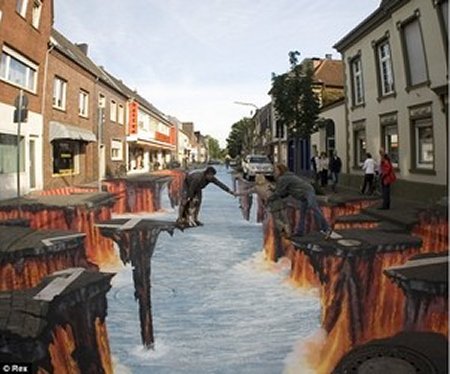 Drawn On A Flat Street With Colored Chalk.
The Oldest Person In The Country.
Eunice Sanborn, 114, of Jacksonville, Texas, USA was born July 20, 1896 in Lake Charles, Louisiana and just celebrated her 114th birthday. Some five years after the death of her 90-year-old daughter, Dorothy, her will to survive has been incredible.
Mrs. Eunice Sanborn, a member of Jacksonville Chapter 377, Order of Eastern Star in Jacksonville, is now the oldest person in America. She was initiated into Jacksonville Chapter in 1926. This makes her an 84 year OES member.
They celebrated her birthday on Tuesday, July 20 at 10 AM at the First Baptist Church, 210 Phillip St. in Jacksonville, Tx.
"She's lived a very long life, and she dates back to the Victorian Era," said Robert Young, with the Guiness Book of World Records. "And she's still with us. I think she needs her honor and to be recognized as living history."
Fewer than 100 people in history have reached the age of 114. According to Guinness, the oldest person in the world is from France, born only a few months earlier than Eunice.
The Pencil Guy
He is currently developing a body of drawings inspired by old lodge portraits. For years the mysterious black and white images of strangely bearded and mustached men, adorned in aprons, jewels and oriental costumes have fascinated him. He is currently making meticulous pencil drawings inspired by some of his favorite found photographs from that era. He hope to eventually mount an art show at a local lodge and evently become a professional portrait artist.
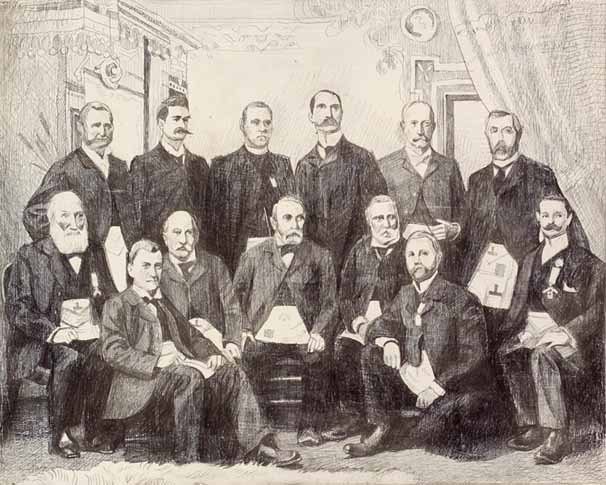 The Brothers
Voices From The Past
For those old enough to remember the days before Facebook…
Be sure to refill the ice trays, we're going to have company.
|
|
All material in this site may be used to educate everyone, Freemasons and non-Freemasons alike about Freemasonry and for the promotion of Freemasonry. A very sincere effort is made to avoid using any copyrighted material, without permission or giving credit to the author and source, in the creation of this web site. If you discover something that is yours, without giving you due credit, please let me know and due credit will be given or the item will be replaced.
|
|
|

